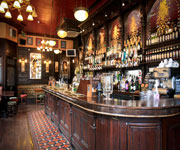The London pub. As deeply connected to the city's cultural identity as double-decker buses, beefeaters and busby-topped sentries – and a darn site more useful. London would be nothing without its immortal inns and timeless taverns, amazing alehouses and brilliant boozers. But across town these stalwart social institutions are being threatened, replaced with cloned, characterless bars or else demolished to make way for blocks of flats.
Want to read UNESCO Daily News Updates? Click Here!!!
Applying for UNESCO World Heritage status
 And that's why a group of students from the landscape, architecture and interior design courses at Kingston University want to see them protected, by applying for Unesco World Heritage status for the London Public House as a 'type'. The school, led by architect Daniel Rosbottom, has chosen world heritage as the theme for the year, which saw students begin with a quick-fire project based on the London pub to open up questions about where heritage resides and the effects, intended and unintended, that designation might have.
And that's why a group of students from the landscape, architecture and interior design courses at Kingston University want to see them protected, by applying for Unesco World Heritage status for the London Public House as a 'type'. The school, led by architect Daniel Rosbottom, has chosen world heritage as the theme for the year, which saw students begin with a quick-fire project based on the London pub to open up questions about where heritage resides and the effects, intended and unintended, that designation might have."When you talk about a special pub and what's unique about it, it suddenly seems a bit futile to only protect the physical elements of the building, without thinking of who uses it and for what," says tutor David Knight, who oversaw an army of 435 students compiling a survey of 87 distinctive or typical London pubs – including one-minute Lumière-style films. "Hopefully our survey can start to describe more than just the physical things, or rather understand how they relate to occupation and the needs of the pub's community," he says.
"For example, it could be that the loss of an upstairs function room has a catastrophic effect on a pub which is used by community groups for meetings, wedding receptions, and so on. Accordingly, our research captures extraordinary examples but it also aims to try and describe the typical or generic qualities of 'London pub-ness' which might influence policy."
The hefty 350-page document, submitted this week to the Department for Culture, Media and Sport, suggests they are deadly serious. And it might not be quite as ridiculous as it sounds. There are many other precedents of listing 'types', or what Unesco calls 'serial sites'. From belfries in France and Belgium to Berlin's modernist housing estates, prehistoric dwellings around the alps, to Flemish beguinages, the London pub would join a growing list of precious typologies.
Beyond the built fabric of the pub, the project also raises interesting questions about the nature of 'intangible heritage', the stuff of oral traditions and performing arts. From Argentine Tango to Azerbaijani carpet weaving, Croatian gingerbread craft to Costa Rican Ox-herding, the lesser-known Peruvian scissor dance to Korean tightrope walking. All have now been designated by Unesco's Intergovernmental Committee for the Safeguarding of Intangible Cultural Heritage.
To make it on to such hallowed lists, the heritage subject must meet a range or criteria in the assessment of Outstanding Universal Value, which include "representing a masterpiece of human creative genius", "containing superlative natural phenomena", "exhibiting an important interchange of human values", and "bearing a unique or at least exceptional testimony to a cultural tradition". If Viennese coffee house culture has made the list, surely our humble London pub can too.









No comments:
Post a Comment